A lot of the most popular fish available in pet- and aquarium stores are surprisingly bad choices for beginners, and some of the least noticed species are actually very easy to care for. This can get very confusing, especially with most stores not being too helpful.
This is why I compiled a list of some the best and worst beginner fish for all the aquarists out there who are confused by all the contradicting info out there. If you’re a beginner trying to stock your aquarium responsibly, you may be surprised to hear which popular fish you’re better off avoiding!
If you’re a beginner, be sure to have a look at the list of best beginner fish as well!
Quick Summary
We’ll provide our thoughts and personal experiences on each of these below, but here’s a quick look at the list and why we don’t love them as a pick for someone just starting out.
| Common Name | Reasons for Inclusion as Worst Beginner Fish |
|---|---|
| Kissing Gourami | Grows large, aggressive, requires at least 85-gallon tank, plant damage |
| Freshwater Angelfish | Needs group, tall tank, at least 80-gallon tank, deformity risks |
| Oscar Cichlid | Large adult size, needs 120+ gallon tank, aggressive to small fish |
| Common and Fancy Goldfish | Bowl myth, needs 20+ gallons per fish, high waste, strong filtration |
| Clown Loach | Grows large, needs group and 75+ gallon tank, sensitive to water quality |
| Bala Shark | Grows large, group living, prone to jumping, needs 100+ gallon tank |
| Puffer Fish | High maintenance, aggressive, specific diet, not for community tanks |
| Large Pleco Varieties | Misunderstood size, needs 150+ gallon tank, not effective algae eaters |
Helostoma temminckii – Kissing gourami, Kissing fish
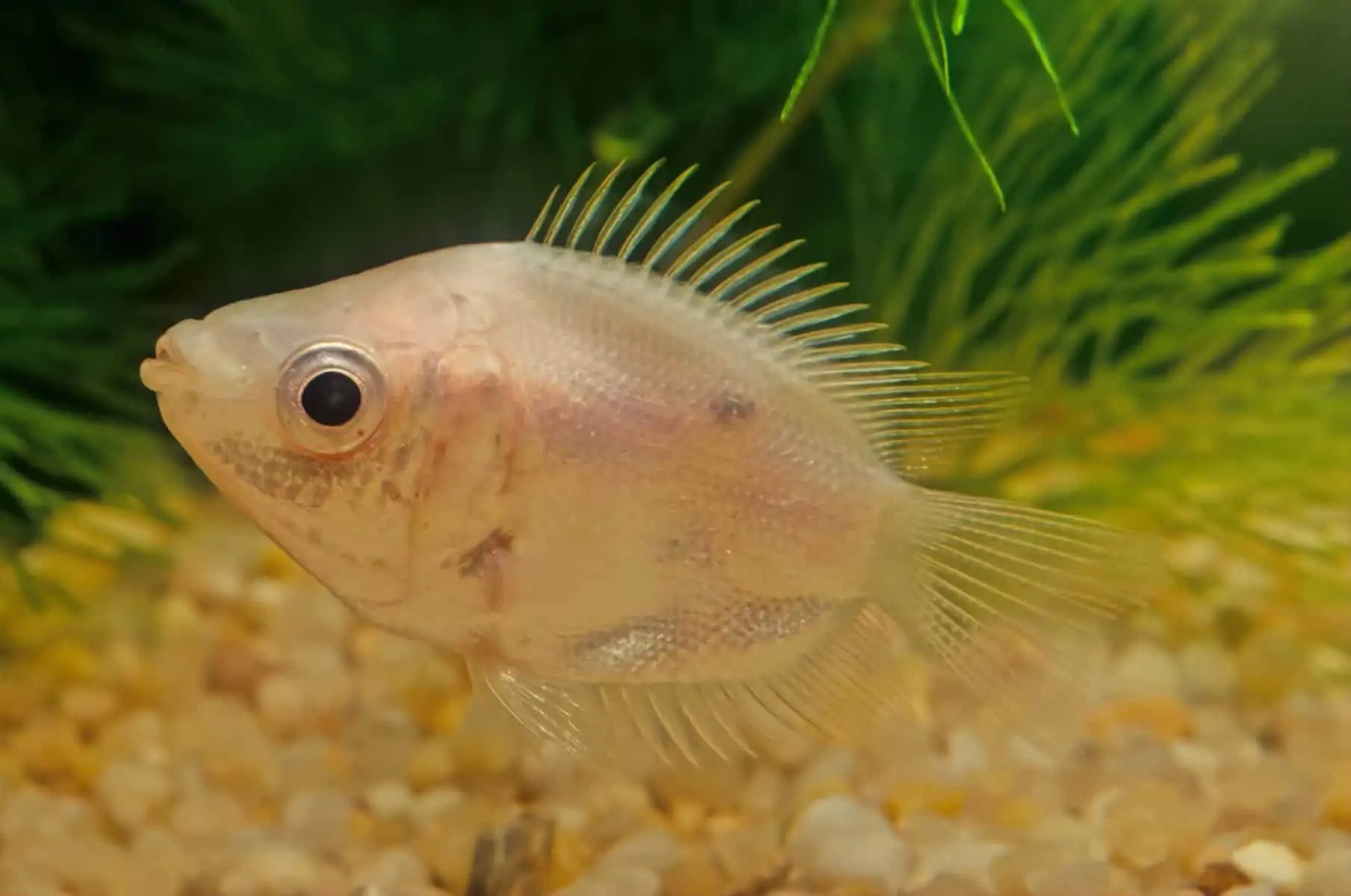
These gourami (pictured above) are popular aquarium fish due to their funny ‘kissing’ behavior. They are a very easy impulse buy and I imagine many are sold every Valentine’s day! What most starstruck lovers don’t realize, though, is that those adorable little fish with their kissy mouths can actually grow to up to 11 inch (25cm).
Maybe not such a good idea for that small tank after all, but unfortunately most people don’t realize this until their kissy fish has already passed away.
The adorable kissing behavior seen in these gourami is actually how they fight, not a display of affection. The fish meet mouths and push each other around the tank to determine which one is stronger. Unfortunately, kissing gourami will also try to defend their territory from other fish species and can literally bully their tankmates to death by attacking and chasing them all day long.
Aquarium plants won’t be treated any better, because kissing gourami are omnivorous and love to nibble at any plants they can find. Kissing gourami are best kept in a large tank: at least 85 gallons (300L) would be a good idea. If you want to keep them with other fish, don’t go for calm, small or defenseless species.
If you’re interested in keeping gourami fish, the smaller varieties on this list might work for you.
Pterophyllum scalare, Pterophyllum altum, etc. – Freshwater angelfish
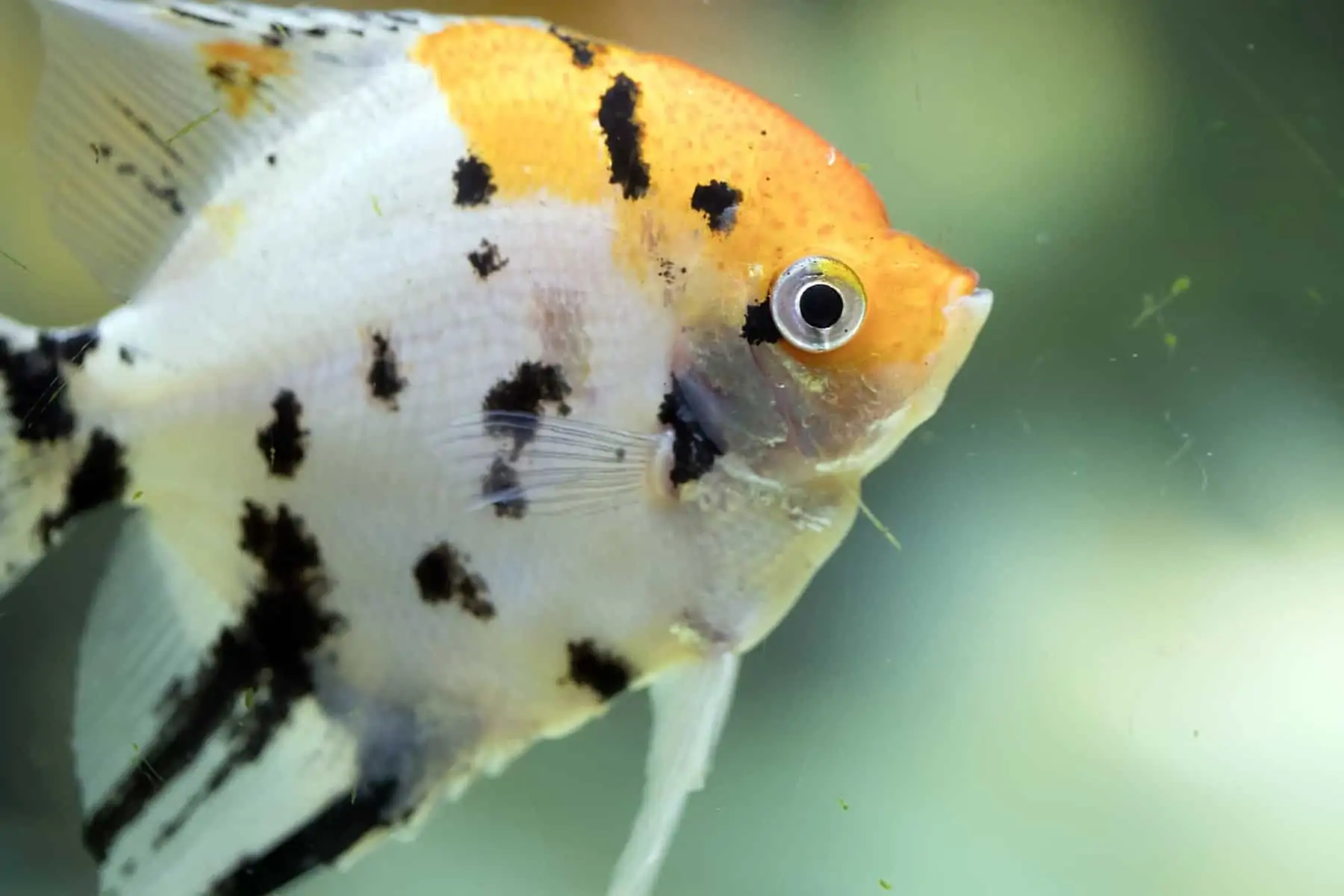
Angelfish can be a gorgeous centerpiece in a tropical aquarium. Few things are more beautiful than a group of these elegant fish swimming alongside one another, foraging and showing their natural behaviour.
Sadly, angelfish are often kept in conditions that prevent them from growing to their true potential and that can even cause growth deformities. Most importantly, don’t keep just one of these fish.
Try to get at least six of them so they can form breeding pairs and feel safe together – for 6 angelfish, an aquarium of at least 80 gallons (300l) is a good place to start. Because of the height they can reach, angelfish are best kept in an aquarium that’s at least 20 inch (50cm) high. This will prevent deformities and gives them space to swim and grow.
If you really want to imitate their natural habitat, go for a South American biotope with dark water and plenty of Amazon sword plants.
Astronotus ocellatus – Oscar cichlid, Velvet cichlid
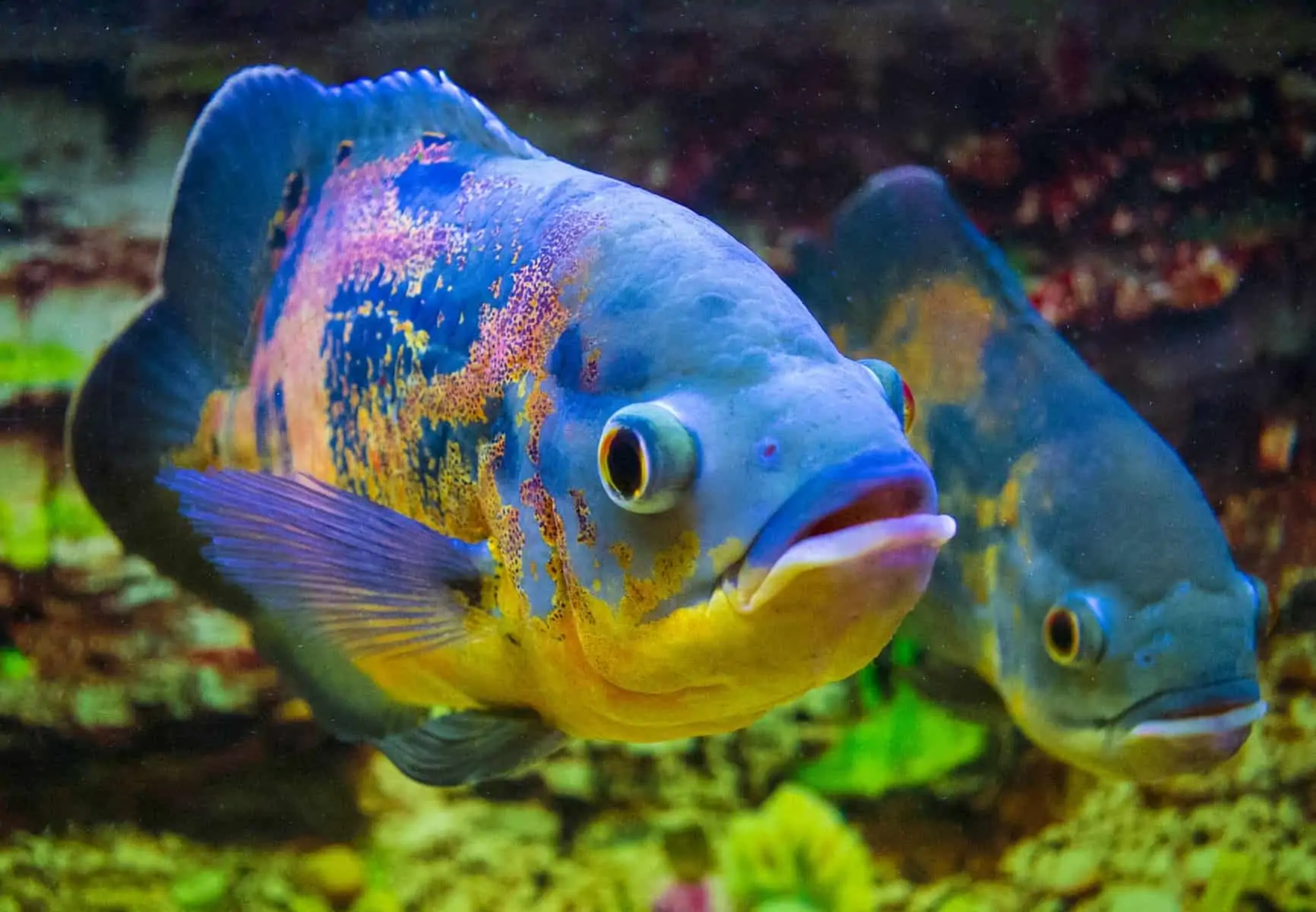
Though not considered extremely difficult to care for, these fish just don’t seem to get what they deserve. Some sites list 30 gallons (115L) as a minimum, but many uninformed fishkeepers choose to house them in even smaller setups. Not a great idea at all, as Oscars can reach a size of 13-14 inch (35cm).
I’d recommend about 120 gallons (450L) for one pair. Don’t go easy on the filtration; you’ll definitely need a canister filter with plenty of room for biological filter material. Don’t house them with smaller fish, because they might just consider those a quick easy meal. Oscar cichlids can be kept by beginners, but starting out with a smaller tank with peaceful fish to gain some experience first may be a better idea.
Carassius auratus – Common and fancy goldfish
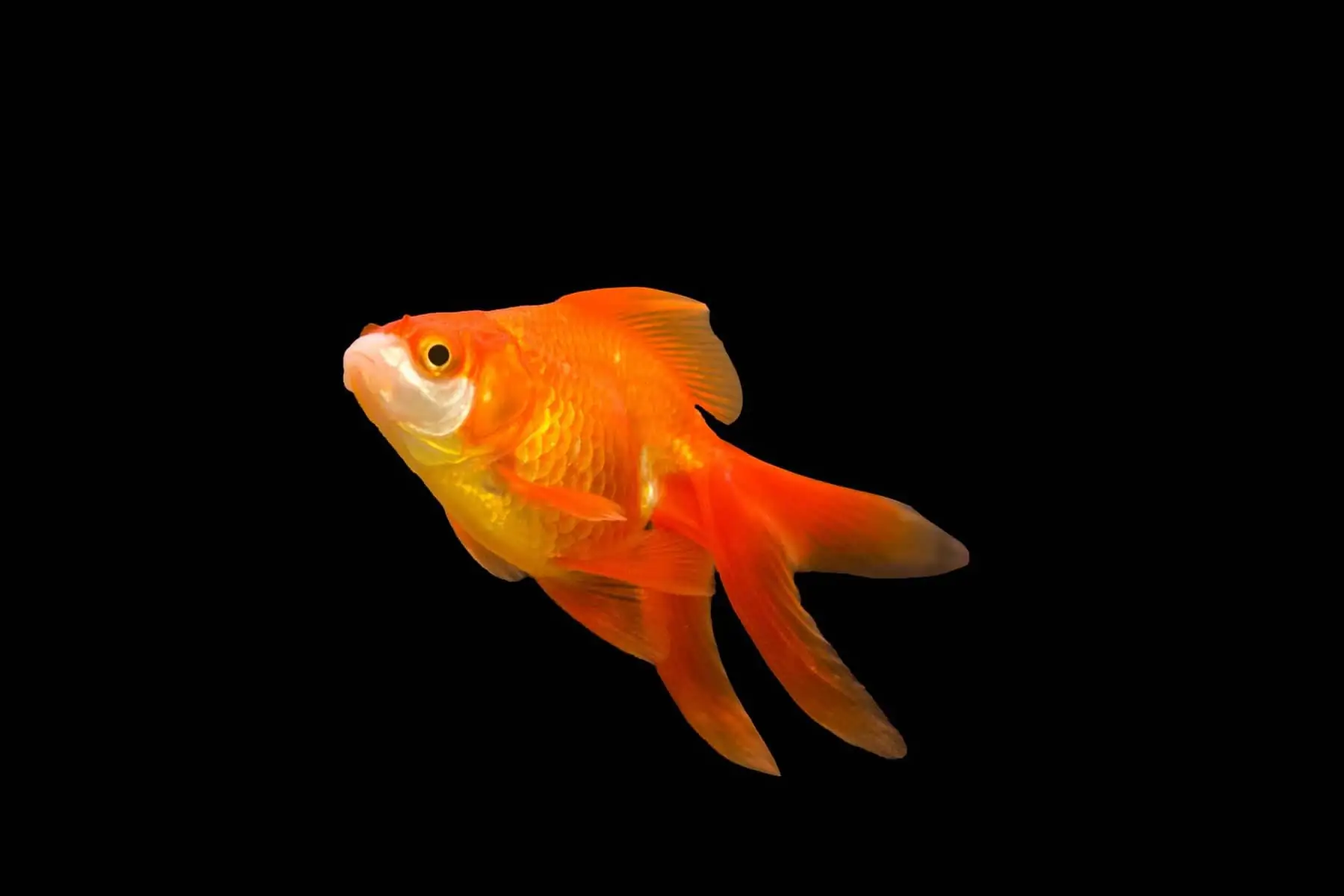
Everyone had one as a kid: a 40 cent feeder goldfish in a bowl. Mine was named Leon and I loved him, until I realized that the Leon I’d had for three years was actually 20 Leons that my parents kept replacing after they died. Goldfish are one of the most popular aquarium fish species, but they are pretty hard to properly care for. Neither common goldfish nor fancies can live in a bowl.
Commons are mainly pond fish, and fancies need at least around 20 gallons (75L) per fish to thrive. They can’t be kept alone, so you’re looking at a minimum of 40 gallons (150L). Why? Because they can grow up to the size of your underarm or foot. And goldfish produce a lot of waste, so a big aquarium isn’t enough; you’re also going to need heavy filtration. External canister filters meant for tanks double the size of your goldfish tank are preferable.
Even though they’re great pets with lovely personalities, goldfish don’t make good beginner pets. Don’t try to win one at the fair if you don’t have the pond or tank for it!
For more information on just why bowls and small tanks aren’t suitable for goldfish have a look at this article. For more information about goldfish keeping, have a look at the common goldfish caresheet and fancy goldfish caresheet.
Chromobotia macracanthus – Clown loach
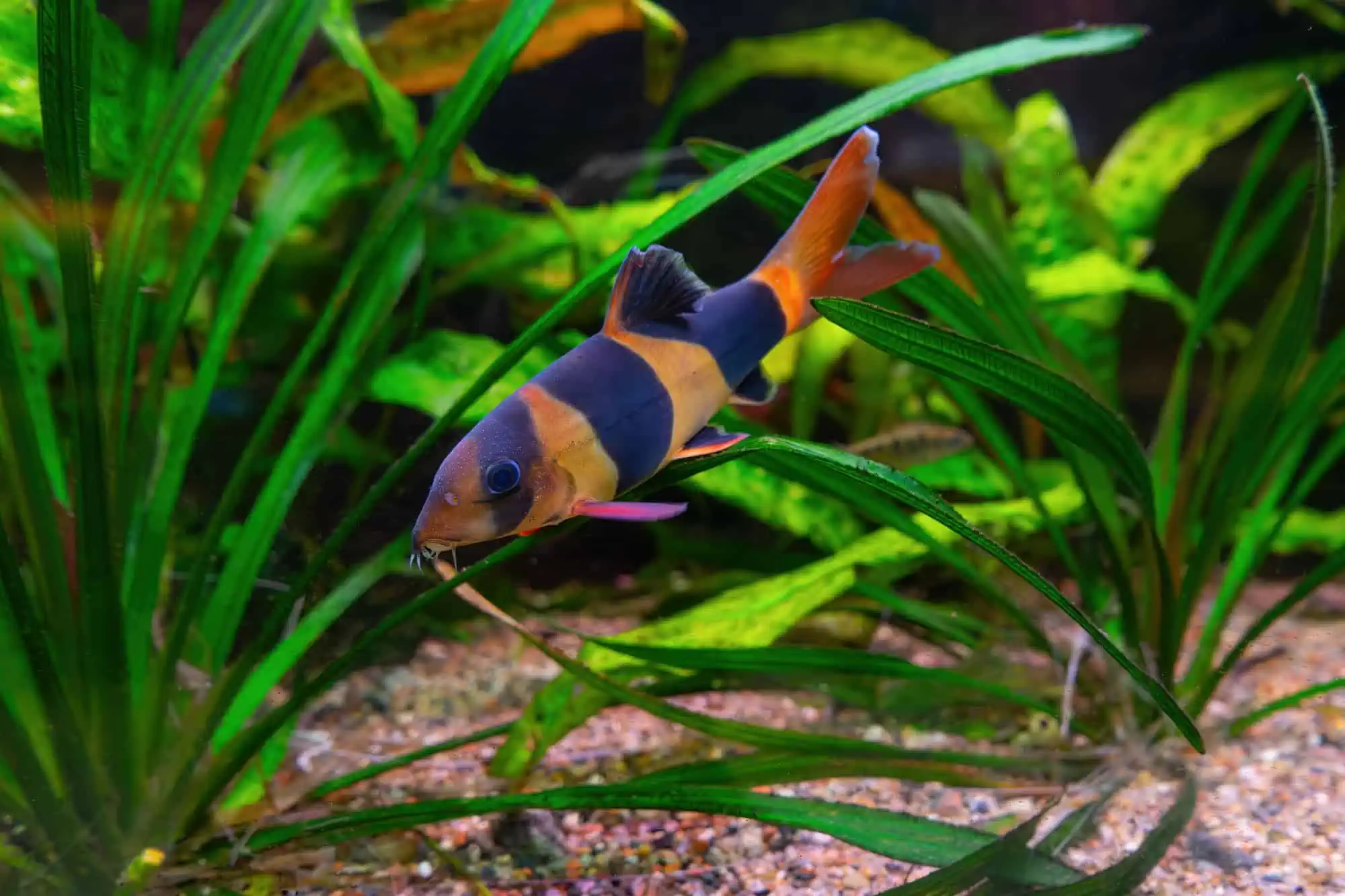
Even though a lot of websites try to warn beginning aquarists about these fish, they’re still sold on a huge scale. When given the right care and enough space, clown loaches will show very interesting behaviour, but unfortunately most of them will never get this lucky. Because they’re usually sold when they’re still very small, it’s kind of hard to imagine that these cute little striped creatures can grow to up to 12 inch (30cm!).
Because of their need to live in groups of at least five, they will need an aquarium of at least 75 gallons (285l) with lots of filtration. Keeping the water extremely clean is a must for these guys, as they are very sensitive.
You can find a full clown loach caresheet here.
Balantiocheilos melanopterus – Bala shark, Shark minnow
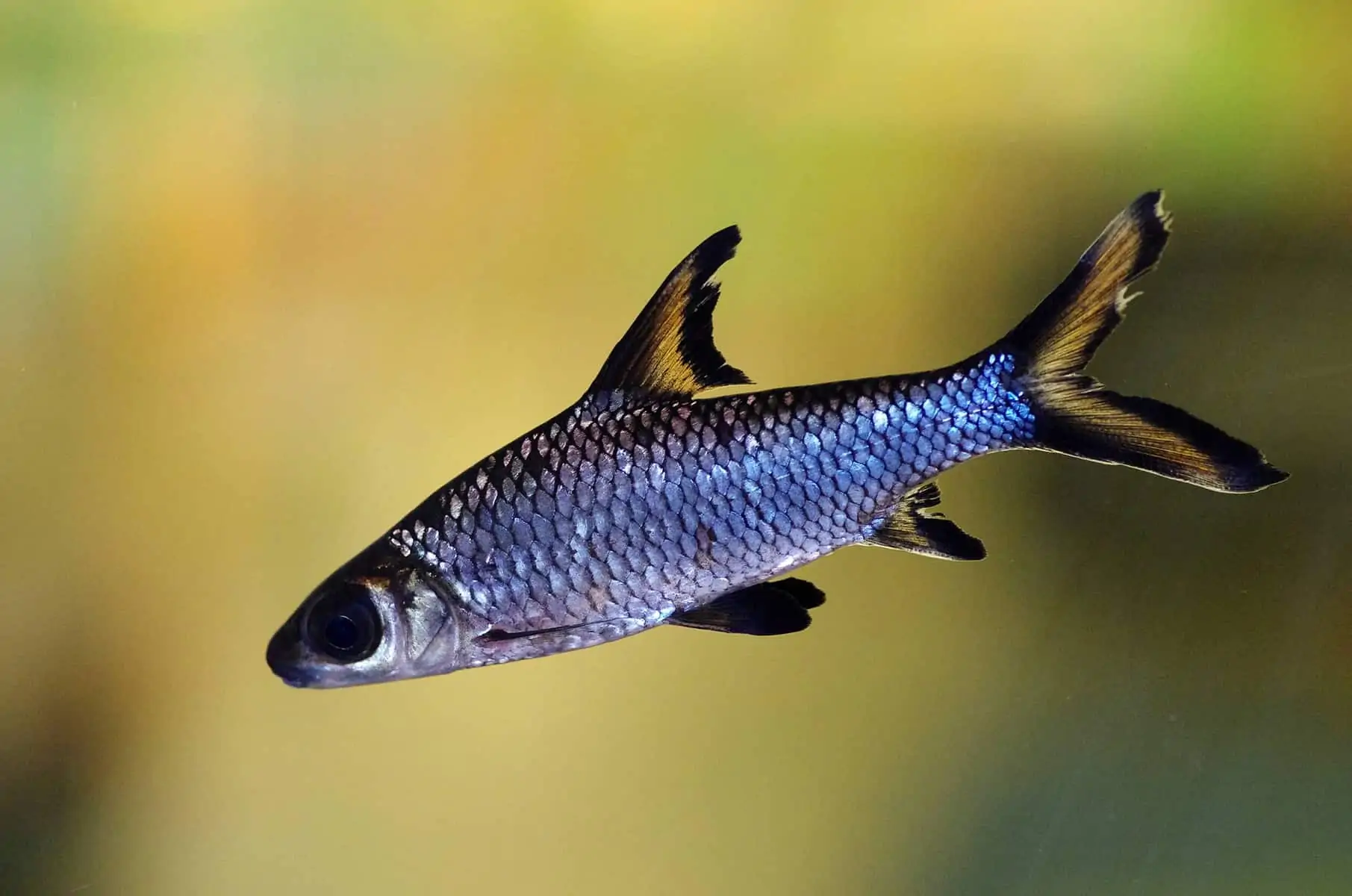
Another one of those cuties that is sold in your average pet store around the corner, where they accidentally ‘forget’ to tell you they can grow to a size of 12 inch (30cm). They should also be kept in groups, will try to jump out of their tank when they get the chance and are actually endangered in the wild. Definitely not a great fish to start out with as a beginner. However, like clown loaches, this species is very interesting to keep.
If you have a 100+ gallon (400+L) aquarium with a width of at least 79 inch (200cm) lying around and are a more experienced fishkeeper, they are actually a great challenge. Be sure to try to find captive bred Bala sharks though, and remember to think before you buy.
Carinotetraodon & tetraodon varieties – Puffer fish, puffers
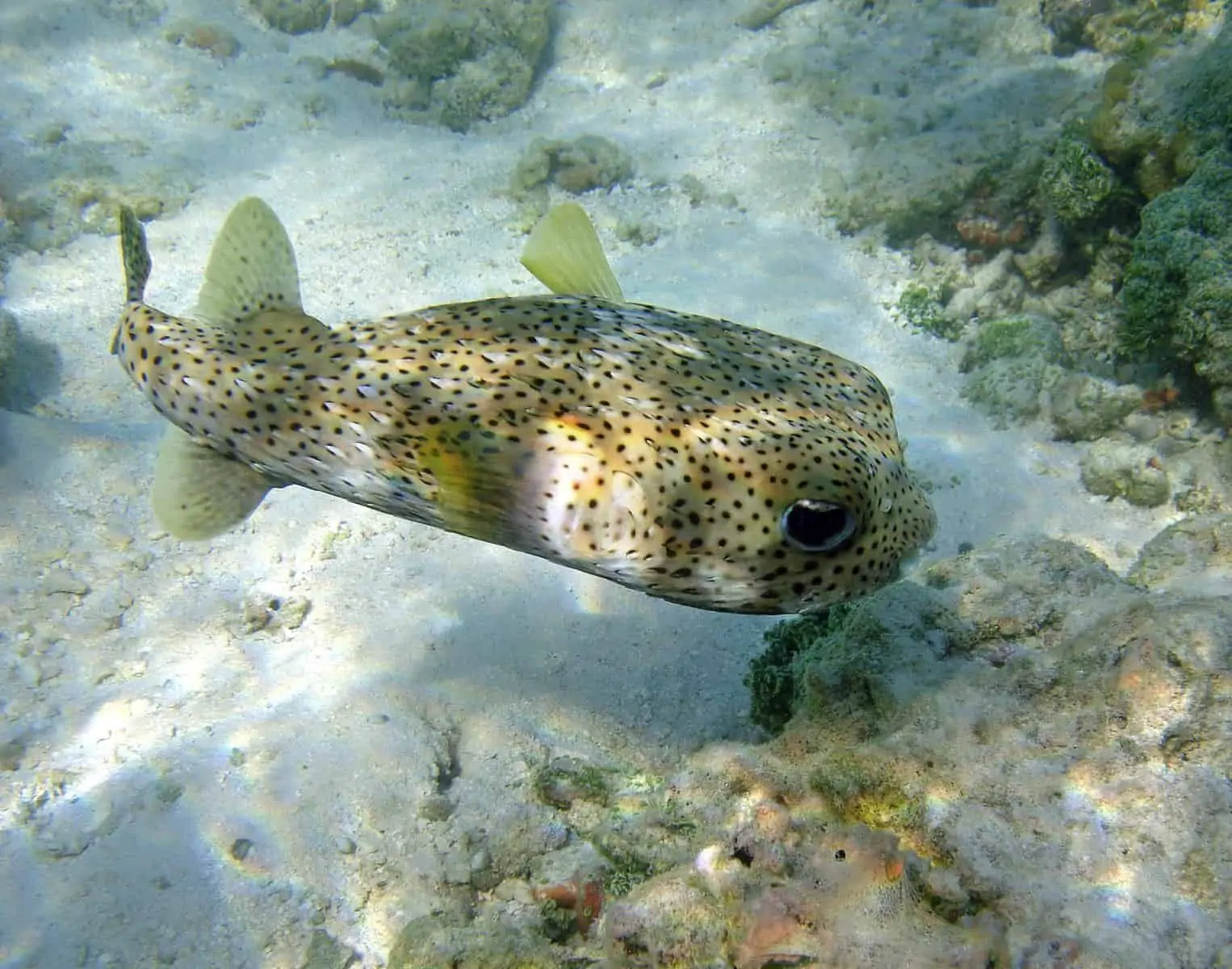
Their intelligence, interesting behaviour and odd looks make puffer fish great pets that can be just as much fun as a cat or dog. There’s one problem though: these fish need very specific care. Their aggressiveness, need for bigger tanks, sensitivity and their specific diets make it very difficult to set up an aquarium for them.
There are many different kinds of freshwater and brackish puffers, but they are all very messy eaters and most species won’t tolerate any tank mates whatsoever, something that has caused many a fish to be brutally slaughtered. Many of people introduce puffer fish into their community aquarium to deal with a snail problem, but after all the snails are eaten, problems start to arise. Before you decide to get any kind of puffer, do your research!
You can find a list of 5 freshwater puffers here.
Hypostomus plecostomus, Glyptoperichthys gibbiceps etc. – Large Pleco varieties
When it comes to people buying fish and being absolutely shocked when doing research afterwards, these guys probably take the prize. Often sold as ‘great algae eaters that will do fine in small tanks’, Pleco varieties like the Sailfin Pleco and Common Pleco can actually grow to an adult size of about 20 inches (50cm), which means they require an aquarium of at least 150 gallons (~570L).
Obviously not a very good choice for smaller setups after all, and to make matters worse, most varieties aren’t even effective at removing algae nor are they suitable for a planted tank. Plants will be dug up and sometimes eaten.
Although they are very hardy and fairly peaceful, I would definitely not recommend these fish for beginners because of the reasons listed above. Ancistrus varieties (Bristlenose Plecos) make a much better choice for beginning aquarists when it comes to Plecos, as they only grow to about 6 inch (15cm). One Bristlenose can comfortably live in a 40 gallon (150L) aquarium.
“Honorable” mentions
Some fish that would normally make fine beginner fish, have been badly bred for so long that inbreeding has made them weak and vulnerable to diseases. Examples of this are Dwarf Gouramis (Trichogaster lalius – formerly Colisa lalia) and Guppies (Poecilia reticulata). Both used to be very hardy and fairly easy to care for, but are now so vulnerable to disease (a study has shown that 22% of all Dwarf Gouramis from Singaporean fish farms carry the Dwarf Gourami iridovirus) that it’s very hard to keep them healthy or even alive.
If you want to keep Dwarf Gouramis or Guppies, I definitely recommend getting them from a reputable breeder. This way you have a better chance of finding healthy fish that won’t die within weeks.
To conclude…
In summary, ensuring the well-being of your fish is paramount—thriving, not just surviving, should be the goal of every aquarist. Remember, a fish might endure less-than-ideal conditions, but that doesn’t make them suitable. Always research before purchasing to provide a proper environment. Opting for a different species is better than compromising on the habitat necessities if the ideal care for a specific fish is beyond your means.
Feel free to suggest additions to this list or share your own experiences. Your input is valuable to the community. Happy fishkeeping, and may your aquariums flourish!

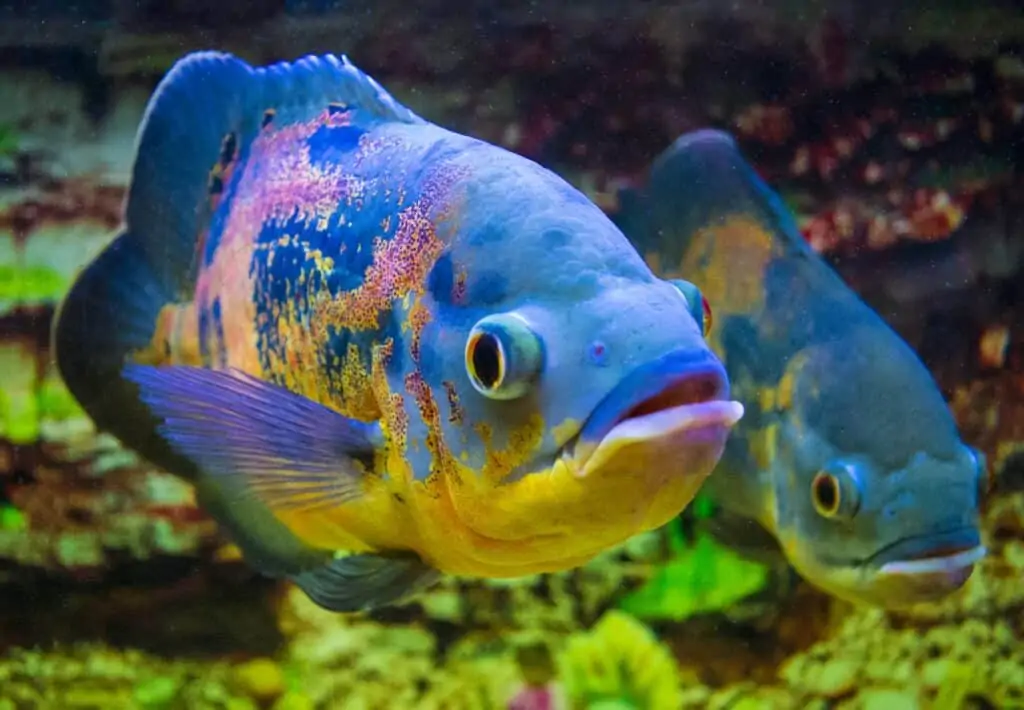






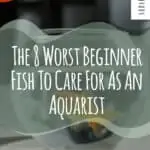
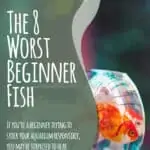

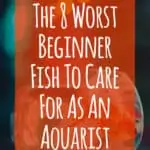


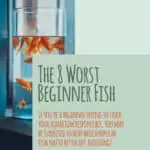
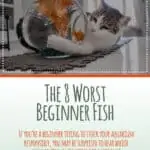
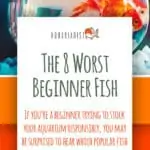
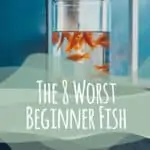
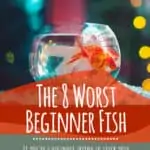
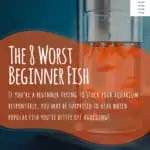
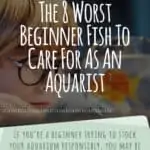


Goldfish are good beginner fish it is just that they need a proper aquarium, good filtration, and regular cleaning. 42 gallons for two Common goldfish. That’s 30 gallons for the first fish and 12 additional gallons for the second fish—30 gallons for two fancy goldfish.That’s 20 gallons for the first goldfish and 10 gallons for the second fish. Great article though
Goldfish require a lot of initial set up, which means a lot of upfront costs. Not too many beginners are aware of this and their long-term commitment!
Multis, yellow labs and N Brichardi were my first tank. All was fine with plenty of hiding places and shells available. Once I started keeping Julidichromis i had problems. I was tired of watching them kill each other. I will say that Khuli loaches managed to stay alive with the cichlids. In my current tank I have 4 khuli loaches 6cherry barbs, 6 neon tetras 6 pristella tetras one clown pleco (he hangs out eating driftwood) and 4 tiny colorful shrimp. In a 29 gallon tank. Sponge filter and a canister filter. Live plants too
I have a 20 gallon tank a heater,filter,fresh water tank,water conditioner and I have a betta fish what other fish would you recommend putting in to a tank like mine?
Hey! So Betta fish tankmates are a bit of a difficult topic with a lot of discussion. Your options are very limited but in a 20 gallon aquarium you do have some possibilities. You can find ’em here in the article on Betta tankmates. 🙂
when i first started keep fish about 2 years ago, i had ( and still have) a 40 gallon tank. i had 3 molly’s for starter fish and put the better in with them. big mistake. but then i added some neon tetra and some harlequin rasbora both are schooling fish and are better to be in groups and my betta was fine with them. try to avoid fish with long fins and too much color.
Ok, so I am about to buy some mini mollies for my slightly aggressive male guppies and I’m also planning on getting 1 flying fox carp, I am removing the corydoras so this carp will thrive. Is it a good idea to keep 1 flying fox (no more bottom feeders) in a 10 gallon?
Hello.
What’s a mini molly exactly? I wouldn’t recommend any type of molly fish for a 10 gallon aquarium, nor a flying fox unfortunately. Both species need much more room. Even for guppies I prefer to go a bit bigger unless it’s a very small group! Fish just need space to thrive.
Good luck!
Some guy at my highschool thinks he is smarter than a nerd but he thinks that 10 gallons for a goldfish is enough,he was horribly wrong because l myself has seen a goldfish double the size of a small pumpkin and yet he insists that he should keep it in a small tank and also he thinks that you could mix largemouth bass with small koi in his pond and that went totally horrible for him,instead he only had one full and satisfied bass left in his pond,what a dumbass right
Sorry to hear that! In most cases if someone is completely convinced they’re doing things right there’s not much you can do, though. They are set in their beliefs and it’s best not to upset yourself trying to convince them 🙂
Why do some websites suggest goldfish and neon tetras a beginner fish,in fact they are horribly wrong,neon tetras can easily die from shock by putting them in your aquarium and l personally have seen a gold fish double the size of a small pumpkin and people still keep them in 5 gallon bowls that l most often refer to as goldfish coffins
There’s still a lot of misinformation out there, but we’re doing what we can! 🙂
My ten gallon has had a few groups of fish in it and after they died I’ve emptied the water, scrubbed off the sludge (staying far away from chemicals) and let cycle for at least two weeks after this process before getting new fish. The tank is empty now and it’s going to cycle for about two weeks before I get some new fish in there. Would a dwarf gourami be too weak to live and prosper in the tank?
I replied to your other comment about the dwarf gourami. In any case, as long as your water values are good and your cycle is intact I don’t see any issues (as long as your previous fish didn’t die of parasites or something else that can be spread to your new stock). Good luck!
Thank you very much! I surely hope the new gourami does well. Your website is very helpful thank you for the reply.
I have a 60 gallon tank with 30 Gouramis. 14 are Dwarfs a mix of regular Dwarves ,Fire and Pale blues. All are thriving. I need some females though. The others are 3 spot blues and golds. Very active tank. No fighting. A little flaring the fins and that’s it. Love these colorful fish.
Hi Donald,
That sounds like a beautiful tank! And that’s great to hear! Sometimes even the most docile fish species can end up being the biggest bully in the tank. It’s just up to chance sometimes.
Happy fishkeeping!
Wonderful article! Thank you for writing, I wish this stuff was more common knowledge. It would save a lot of fish if everybody could look over this before deciding to buy them.
Glad you appreciated the article! 🙂
How is a common thought tank size for an Oscar 30 gallons? I’ve seen Oscars the size of my 20 gallon, LITTERALY! I agree with your 120 gallon minimum, even though I have seen a well thriving Oscar in a 75 in my LFS (the owner actually takes care of the fish he keeps, and his employees have to know about the kind of fish by personal experience to offer advice, which is kewl). They really do love all the space they can get.
I know right?! I don’t understand it either. I included that because I came across multiple sites that listed something around that size while fact-checking for this article. And great to hear your local pet store owner takes good care of his fish, at least that way you can buy fish without having to worry about supporting bad animal husbandry 🙂
Personally, I think neon tetras could be on this list. They are thought of as stater fish by many people and because they are so colorful they are usually added to aquariums. However they are sensitive to water chemistry, particularly ph, so many die unless in mature aquariums. Add that to the fact they should be in schools so they should have a bigger tank despite their small size.
Thanks for the input! I actually never had much trouble with them, although I agree that many people have no idea what size tank they need.
Hi Mari. I have 5 tropical fish (1x molly 1x guppy 3x platy) and one Dwarf Flame Gourami. Is it a bad idea to only keep one or should I have pairs? Also he seems to be a tad sluggish but I think it might just be because he’s still getting used t the new tank. Is correct or is this a problem? I only got him today and have very good water quality so I don’t really know if there is anything wrong. He seems a little anti-social sort of in one corner all the time. Is this normal of Dwarf Gouramis?
Hi! There are unfortunately a few things wrong with your stock. The livebearers are all group fish, so if you want to keep them I would get rid of the molly and the guppy and expand my group of platies. It’s not ideal to even keep livebearers with dwarf gouramis, though, as they are both shy and territorial – that might explain his behavior, although if you’ve only had him for a day it could also be stress. As for keeping gouramis in pairs, that seems to be what most people do and recommend!
In conclusion, I would personally figure out whether you want to keep gouramis or livebearers and then adjust your stock based on that, as the current situation is not ideal. I’m not sure what kind of tank you have, but be sure to keep in mind these species all need at least 15 gallons!
Good luck 🙂 feel free to ask if you need any more help.
What about elephant fish and the feeder 15 cent goldfish that gets to be a foot long and all of your other fish that can fit in its mouth disappear?
Agreed! Goldfish are already mentioned, but elephant fish are indeed a pretty bad beginner fish as well. They are super sensitive, need really big tanks and are difficult to combine with other fish. Definitely not ideal for beginners!
And don’t forget the Red-tailed shark. The peaceful, playful schooling fish- Until it grows up.
very true but what about…let me think for a sec…aha! discus, tiger barbs, and dyed fish.i think you should do these fish.
You’re right! Especially discus, I’ve seen some disastrous discus setups.
Six discus. Tank size?
Difficult topic! A general guideline is 50 liters, or about 13 gallons, per discus. Some have different opinions on the matter, though – you can view here, for example, what one of the lead discus breeding companies has to say about it. They prefer smaller tanks, especially for young fish, but that would mean you’d have to watch your water quality like a hawk.
What is a good beginner fish then?
You can find a list with better beginner fish here! 🙂
Thank You for the very advisable information! Many, if not all beginners make this mistake and choose species not suitable for beginners due to its size or behavior. Unfortunately pet shops personal very often gives totally wrong suggestion concerning good beginners fish.
I agree! It’s a pity pet stores don’t try harder to give good info.
Another fish that’s really popular (in the US at least) is bettas. People have this idea that they can live in bowls, vodka bottles and other similar containers. A lot of this is due to lack of education from pet stores and people trying to be ‘hip’ and keep them as decorations. 🙁
I know, the betta thing is absolutely ridiculous, I see it all the time and it really upsets me sometimes 🙁 I didn’t put them in this list because they’re actually not bad beginner fish at all, they’re relatively easy to care for but people STILL refuse to give them what they need.
I’ve kept Dwarf gourami before, and sure enough they kept in a pack and bullied most tankmates to death rather quickly, like their cousins, the kissing gourami. Luckily myself and my dad noticed the pattern and stopped getting small tankmates
That’s a pity 🙁 I think it’s because they prefer calm tankmates, so they get nippy and territorial towards the ones that are less calm.
One more fish that is a good honorable mention is the dwarf gourami. I don’t know if you have the same trouble in Europe, but in the US there is a large problem with the dwarf gourami iridovirus. Many sellers in the US get their fish from farms in Asia and a staggering 40% of dwarf gourami that come from these farms are carrying the virus. There is no cure for it, and the fish just wastes away. 🙁
I did hear from a lot of people that dwarf gouramis are weak due to inbreeding and viruses, they’d be fine as a beginner fish if it weren’t for that. :(Guppies have the same problem, I think I’ll include those two in the article. Thank you for the tip 🙂